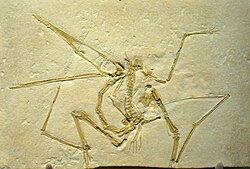| Pterodactylids | |
|---|---|
 | |
| Cast of the sub-adult type specimen of Pterodactylus antiquus | |
| Scientific classification | |
| Kingdom: | Animalia |
| Phylum: | Chordata |
| Order: | † Pterosauria |
| Suborder: | † Pterodactyloidea |
| Infraorder: | † Archaeopterodactyloidea |
| Clade: | † Pterodactylidae Bonaparte, 1838 |
| Subgroups | |
Pterodactylidae is a controversial group of pterosaurs. During the 2000s and 2010s, several competing definitions for the various Jurassic pterodactyloid groups were proposed. Pereda-Suberbiola et al. (2012) used Fabien Knoll's (2000) definition of the name Pterodactylidae. [1] Knoll had defined Pterodactylidae as a clade containing " Pterodactylus antiquus , Ctenochasma elegans , their most recent common ancestor and all its descendants". [2] Using this definition with the analysis conducted by Pereda-Suberbiola et al. (2012) meant that Ctenochasmatoidea was nested inside Pterodactylidae. [1]